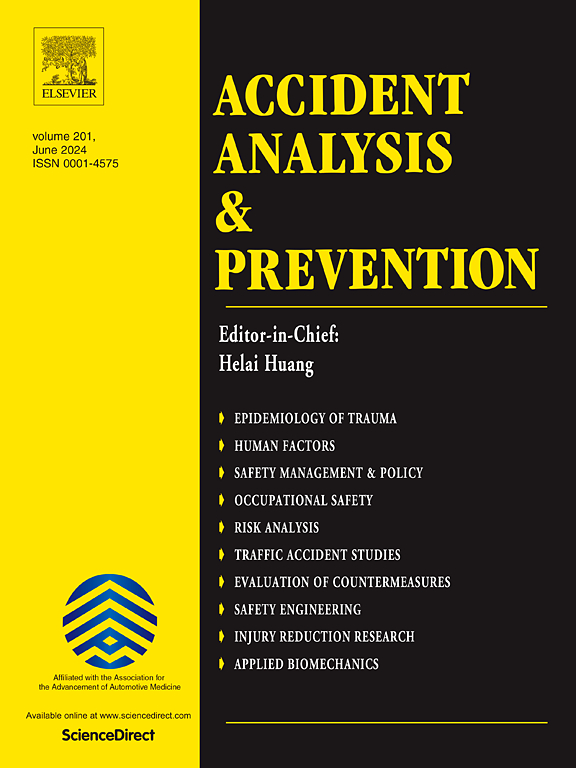A dynamic and stochastic perspective on time headway in traffic oscillations and its implications for traffic safety
IF 6.2
1区 工程技术
Q1 ERGONOMICS
引用次数: 0
Abstract
Traffic oscillations refer to the alternating patterns of vehicle deceleration and acceleration in congested conditions, which usually create significant safety concerns on freeways. Thus, it is imperative to understand the mechanisms of traffic oscillations and their underlying safety implications. This paper presents a novel approach to exploring the combined effects of dynamic time headway (DTH) and stochasticity on traffic oscillations during car-following. Using high-precision trajectory data, we demonstrate a strong correlation between DTH and stochasticity strength with the power functions of speed. We then extend the car-following model framework that considers both the dynamic characteristics and stochasticity of time headway to investigate the mechanisms of traffic oscillation. The model calibration and validation results demonstrate that our extended model outperforms the original model in terms of trajectory fitting accuracy, successfully replicating the asymmetric driving behavior and the concave growth pattern of speed standard deviation. Building upon this novel perspective, linear stability and safety evaluation are systematically conducted to understand the comprehensive influence of DTH and stochasticity. Our theoretical and numerical experiments show that DTH significantly increases the range of string instability in traffic flow, particularly at low-speed regimes. The influence of the stochasticity on the marginal stability of traffic flow shows a pattern of increasing followed by decreasing tendencies. Also, the combined effect of drivers’ DTH characteristics and stochasticity could expand the rear-end collision risks at low-speed regimes, showing a backward diffusion effect. Our findings further establish the interconnection of traffic oscillations with traffic stability and safety concerns.
交通振荡时距的动态和随机分析及其对交通安全的影响
交通振荡是指车辆在拥挤条件下减速和加速的交替模式,通常会引起高速公路上的重大安全问题。因此,有必要了解交通振荡的机制及其潜在的安全影响。本文提出了一种新的方法来研究动态车头时距(DTH)和随机性对车辆跟随过程中交通振荡的综合影响。利用高精度的轨迹数据,我们证明了DTH和随机强度与速度的幂函数之间有很强的相关性。在此基础上,我们扩展了同时考虑车头时距动态特性和随机性的车辆跟随模型框架,探讨了交通振荡的机理。模型标定和验证结果表明,扩展模型在轨迹拟合精度上优于原模型,成功地复制了非对称驾驶行为和速度标准差的凹增长模式。基于这一新颖的视角,系统地进行了线性稳定性和安全性评估,以了解DTH和随机性的综合影响。我们的理论和数值实验表明,DTH显著增加了交通流中串的不稳定性范围,特别是在低速状态下。随机性对交通流边际稳定性的影响表现出先增大后减小的趋势。驾驶员潜深特性与随机性的共同作用会扩大低速状态下的追尾风险,呈现反向扩散效应。我们的研究结果进一步确立了交通振荡与交通稳定和安全问题之间的相互联系。
本文章由计算机程序翻译,如有差异,请以英文原文为准。
求助全文
约1分钟内获得全文
求助全文
来源期刊

Accident; analysis and prevention
Multiple-
CiteScore
11.90
自引率
16.90%
发文量
264
审稿时长
48 days
期刊介绍:
Accident Analysis & Prevention provides wide coverage of the general areas relating to accidental injury and damage, including the pre-injury and immediate post-injury phases. Published papers deal with medical, legal, economic, educational, behavioral, theoretical or empirical aspects of transportation accidents, as well as with accidents at other sites. Selected topics within the scope of the Journal may include: studies of human, environmental and vehicular factors influencing the occurrence, type and severity of accidents and injury; the design, implementation and evaluation of countermeasures; biomechanics of impact and human tolerance limits to injury; modelling and statistical analysis of accident data; policy, planning and decision-making in safety.
 求助内容:
求助内容: 应助结果提醒方式:
应助结果提醒方式:


